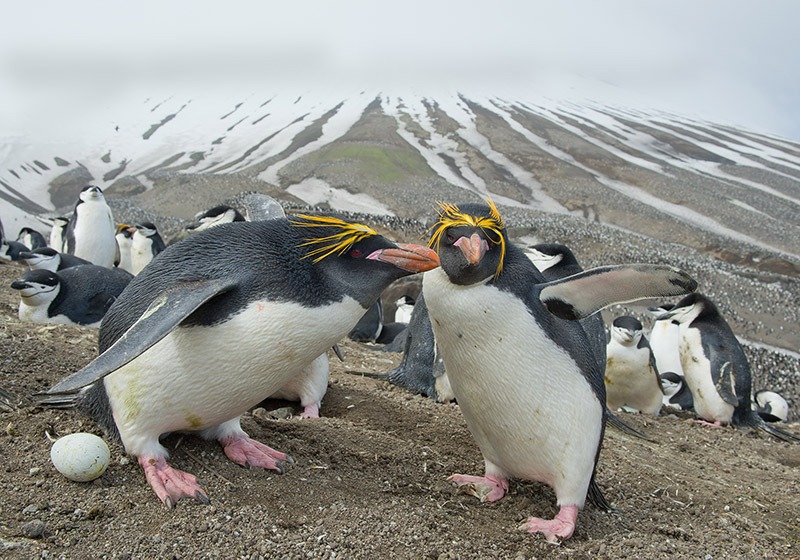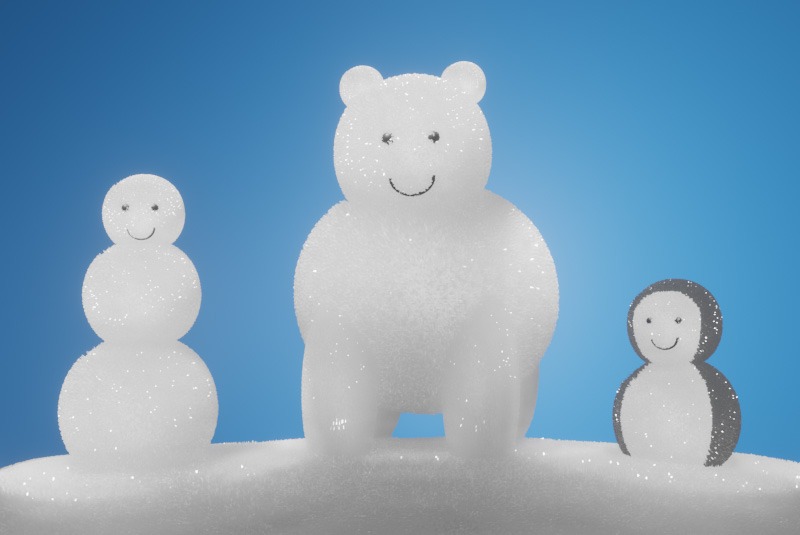Due to the ongoing COVID-19 pandemic, many children will miss out on spending time with friends and family this winter as temperatures drop in much of the country and outside gatherings are made more challenging. The good news is that the parts of the country hit hardest by winter weather also provide the most opportunities for one of winter’s greatest pastimes: snow sculpture. Here at the Rockefeller Institute of Government we have mapped, at the county level, locations that are likely to have enough snow accumulation during January to build a version of three basic snow sculptures: the snow penguin (two vertically stacked spheres of snow), the snowpal (three vertically stacked spheres of snow), and the snow polar bear, which is suitable to be carved out of any giant pile of snow.
The snow penguin and snowpal are both constructed from rolled spheres of compacted snow of different sizes. To create a snow penguin, you will need two snowballs; to make a snowpal, you’ll need three. The snowballs should be stacked in descending size order (with the largest on the bottom). You will notice that the total volume of these compact snowballs is less than the total volume of the ground snow they contain. This is because they are denser and have more water per cubic inch.
Constructing the spheres traditionally requires forming a softball or grapefruit-sized snowball by compacting the snow by hand. After making this starter snowball remember not to throw it anyone no matter how tempting it may be to do so— you’ll need it to roll the larger sphere. Taking the hand-formed snowball, roll it over fresh snow to gather more layers. Make sure to change directions periodically to create a spherical rather than a cylindrical shape. As the snowball becomes heavier it will pick up more snow so you may begin to see grass underneath the snow. Continue rolling until the snowballs are the appropriate size (see “Official snow sculpture dimensions” below).
The snow polar bear, by comparison, benefits from a different construction strategy. While snowballs can be rolled to create legs, a body, and a head, a much more efficient strategy is to find a giant pile of snow, such as a plow pushes to the side of a parking lot or is cleared from a roof, and sculpt the legs, body, and head from the pile in a subtractive fashion. (Reminder: snow is heavy and can collapse so always be aware of your surroundings while sculpting, and maybe bring a buddy.)
Official snow sculpture dimensions (as deemed by the Rockefeller Institute)
The official snow penguin is 28 inches tall. These measurements are based off the macaroni penguin, the world’s most abundant (and aptly named) species of penguin. Constructing this penguin requires two snowballs, the base 20 inches in diameter, and the head eight inches in diameter. Assuming that one-third of the snow on the ground is unusable (lost to spontaneous snowball fights, trampled mercilessly underfoot, or dyed a peculiar shade of goldenrod) and that the remaining snow compresses to one-third of its volume when packed, a snow penguin can be built with one to three inches of snow on a 20-foot by five-foot path of ground, such as the strip of grass between sidewalk and street. (We’ve included some wiggle room in the amount of snow required for reasons mentioned below). Other members of the penguin family can be built with smaller or larger amounts of snow. The blue penguin, for example, is only 10 inches tall and can weigh less than three pounds. By contrast, the emperor penguin stands four feet tall and can weigh almost 100 pounds. When planning your snow sculptures remember that penguins and polar bears do not share the same habitat and at least one neighborhood onlooker will inevitably remind you of that fact if they’re located together.

Macaroni penguin.
Snowpals can also come in many sizes too, but most people are taller than most penguins. Adult and child snowpals have slightly different sphere ratios just as children and adults have different body types. A six-foot adult snowpal is composed of a 12-inch diameter head, 24-inch diameter torso, and 36-inch diameter legs. A four-and-a-half-foot child snowpal is composed of a 12-inch diameter head, 18-inch diameter torso, and 24-inch diameter legs. The child snowpal would require between three and seven inches of snowfall on the same 20-foot by five-foot patch mentioned above. The adult snowpal requires between seven and thirteen inches of snow in the same sized area.
Simply put, you need a lot of snow to create a snow polar bear. If you can’t find a big pile of snow, we recommend mounding the 13 or more inches of accumulated snow on your chosen 20-foot by five-foot snow patch then chipping away with shovel, snow scrapers, or whatever else you have on hand. It is important to create a snow polar bear of sufficient size to inspire fear in your neighbors. There is no math to be done here, only glorious artistic inspiration. Go big.
A note on wiggle room: snow is far from uniform. Building a snow sculpture depends not only on the inches of snow accumulation and size of the outdoor space covered in snow, but also on the outside temperature during snowfall, outside temperature during snow construction, water content of the snow, elevation, and time between snowfalls and snow construction. Consider the following factors in addition to total snow accumulation when determining when and what to build with your snow.
- Air Temperature. Air temperature helps determine how dense snow is. The colder the air, the less dense the snow. Snow that falls right at freezing (32 degrees Fahrenheit) is the densest weighing about 4 pounds per cubic foot. This means that a baseball infield covered in a foot of snow would way about 30 tons. That same foot of snow would only have a density of 4.2 pounds per square foot and weigh 17.2 tons if it falls at 0 degrees Fahrenheit, so in colder weather more snow is required to create comparably sized snow sculptures.
- Elevation. Elevation affects snow fall for two reasons. First, air is generally colder at higher elevations so higher elevation areas are more likely to be cold enough for snow to form. It is easy to trace mountain ranges across the US through the snow accumulation map. Mountains can also cause orographic uplift which happens when moist air tries to travel over mountains, cools, condenses, and turns into snow or rain. This high elevation snow is not necessarily good for snow sculpting. The snow that Utah refers to as “the greatest snow on earth” might be good for skiing because of how dry and light it is, but that powder contains very little moisture and the structure of the flakes makes it difficult to compress into snowballs for construction.
- Timing of Snowfall. Those of us who grew up in the snowier parts of the Midwest and Northeast know that it is much easier to build a snow sculpture after a large overnight snowstorm than from a series of one- or two-inch snowfalls due to ice-ification. Ice-ification (a term we have admittedly made up) is the process of snow becoming harder and full of larger ice crystals after the top layer melts slightly during warmer daylight hours and then refreezes during colder nighttime hours. This is the type of snow that crunches as you fall through the top layer and frustrates would be snow sculptors seeking to roll snowballs. This is why it is always best to immediately build your snow sculpture after any sizeable snowfall.
In addition to adequate snowfall, snow sculptors will require occasional trips inside for warming and sustenance. Be sure to have hot cocoa, soup, or grilled cheese ingredients on hand before the snow begins to fall.

